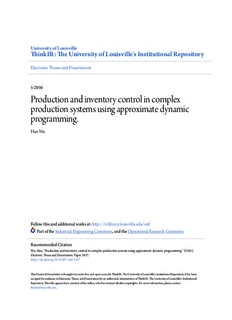Table Of ContentUUnniivveerrssiittyy ooff LLoouuiissvviillllee
TThhiinnkkIIRR:: TThhee UUnniivveerrssiittyy ooff LLoouuiissvviillllee''ss IInnssttiittuuttiioonnaall RReeppoossiittoorryy
Electronic Theses and Dissertations
5-2016
PPrroodduuccttiioonn aanndd iinnvveennttoorryy ccoonnttrrooll iinn ccoommpplleexx pprroodduuccttiioonn ssyysstteemmss
uussiinngg aapppprrooxxiimmaattee ddyynnaammiicc pprrooggrraammmmiinngg..
Han Wu
Follow this and additional works at: https://ir.library.louisville.edu/etd
Part of the Industrial Engineering Commons, and the Operational Research Commons
RReeccoommmmeennddeedd CCiittaattiioonn
Wu, Han, "Production and inventory control in complex production systems using approximate dynamic
programming." (2016). Electronic Theses and Dissertations. Paper 2457.
https://doi.org/10.18297/etd/2457
This Doctoral Dissertation is brought to you for free and open access by ThinkIR: The University of Louisville's
Institutional Repository. It has been accepted for inclusion in Electronic Theses and Dissertations by an authorized
administrator of ThinkIR: The University of Louisville's Institutional Repository. This title appears here courtesy of the
author, who has retained all other copyrights. For more information, please contact thinkir@louisville.edu.
PRODUCTION AND INVENTORY CONTROL IN COMPLEX
PRODUCTION SYSTEMS USING APPROXIMATE DYNAMIC
PROGRAMMING
By
Han Wu
A Dissertation
Submitted to the Faculty of the
J.B. Speed School of Engineering of the University of Louisville
in Partial Fulfillment of the Requirements
for the Degree of
Doctor of Philosophy
in Industrial Engineering
Department of Industrial Engineering
University of Louisville
Louisville, Kentucky
May 2016
Copyright 2016 by Han Wu
All rights reserved
PRODUCTION AND INVENTORY CONTROL IN COMPLEX
PRODUCTION SYSTEMS USING APPROXIMATE DYNAMIC
PROGRAMMING
By
Han Wu
A Dissertation Approved On
November 30, 2015
by the following Dissertation Committee:
Dr. Gerald Evans Dissertation Director
Dr. Kihwan Bae Dissertation Co-Director
Dr. Suraj M. Alexander
Dr. Lihui Bai
Dr. Dar-jen Chang
ii
ACKNOWLEDGEMENTS
It is with great pleasure that I take this opportunity, to thank the people who
have made my dissertation possible.
Foremost, I would like to express my sincerest gratitude to my advisor Dr.
Gerald W. Evans for his continuous support in my Phd study and research. Also for
his understanding, patience, and enthusiasm. His guidance helped me throughout
my research and writing of this dissertation.
Secondly, I would like to thank my dissertation co-advisor Dr. Ki-Hwan
Gabriel Bae. His brilliant suggestions were indispensable for my Phd research.
I would also like to thank Dr. Suraj Alexander and Dr. Lihui Bai. I am very
grateful for their suggestions to my research and help for the course work during the
early stages of my Phd study.
Moreover, I wish to thank Dr. Dar-Jen Chang for his interest in my research
and kindness in sharing his knowledge outsides the Industrial Engineering area to
inspire my research.
Finally, I need to thank for my parents, my girlfriend Chen Zhou, and all my
friends in the United States and China for their continuous support and
encouragement.
iii
I dedicate this dissertation to those who have helped me reach this point, and
those who will help me in my future life.
iv
ABSTRACT
PRODUCTION AND INVENTORY CONTROL IN COMPLEX PRODUCTION
SYSTEMS USING APPROXIMATE DYNAMIC PROGRAMMING
Han Wu
November 30, 2015
Production systems focus not only on providing enough product to supply
the market, but also on delivering the right product at the right price, while
lowering the cost during the production process. The dynamics and uncertainties of
modern production systems and the requirements of fast response often make its
design and operation very complex. Thus, analytical models, such as those involving
the use of dynamic programming, may fail to generate an optimal control policy for
modern production systems.
Modern production systems are often in possession of the features that allow
them to produce various types of product through multiple working stations
interacting with each other. The production process is usually divided into several
stages, thus a number of intermediate components (WIP) are made to stock and
wait to be handled by the next production stage. In particular, development of an
v
efficient production and inventory control policy for such production systems is
difficult, since the uncertain demand, system dynamics and large changeover times
at the work stations cause significant problems. Also, due to the large state and
action space, the controlling problems of modern production systems often suffer
from the “curse of dimensionality”.
In this dissertation, we generalize problem associated with the controlling of
production systems as a stochastic-dynamic decision making problem for multiple
machines with intermediate products, and compare it to the classic Stochastic
Economic Lot Scheduling Problem.
To address the complexity optimizing control process of systems facing
uncertain demands, system dynamics and large changeover time, we first proposed
an adjusted (s,S) policy, and optimize it through the use of a simulation model.
Also, two advanced Approximate Dynamic Programming (ADP) methods are
proposed to handle the “curse of dimensionality”, thus helping the system to make
decisions at particular states. One of the ADP methods is based on a set of linear
regression models to approximate the value function of the state. The other ADP
method is based on an Artificial Neural Network model which is designed to capture
the features of this problem and also embed the adjusted (s,S) policy.
The proposed methods are tested on a small numerical example and also
applied to an assembly line for dishwashers which requires multiple types of wire
racks that must be fabricated and coated at different work centers before supplying
vi
the assembly lines. The near optimal production and inventory control policies are
developed through the proposed methods. These proposed methods, especially the
ADP methods, can be extended to any similar production system, or solve similar
problems in other fields.
vii
Description:modeled as Markov Decision Processes (MDPs) Applications include glass and paper production, injection molding, metal stamping, semi-continuous chemical processes, and bulk production of consumer products such.

